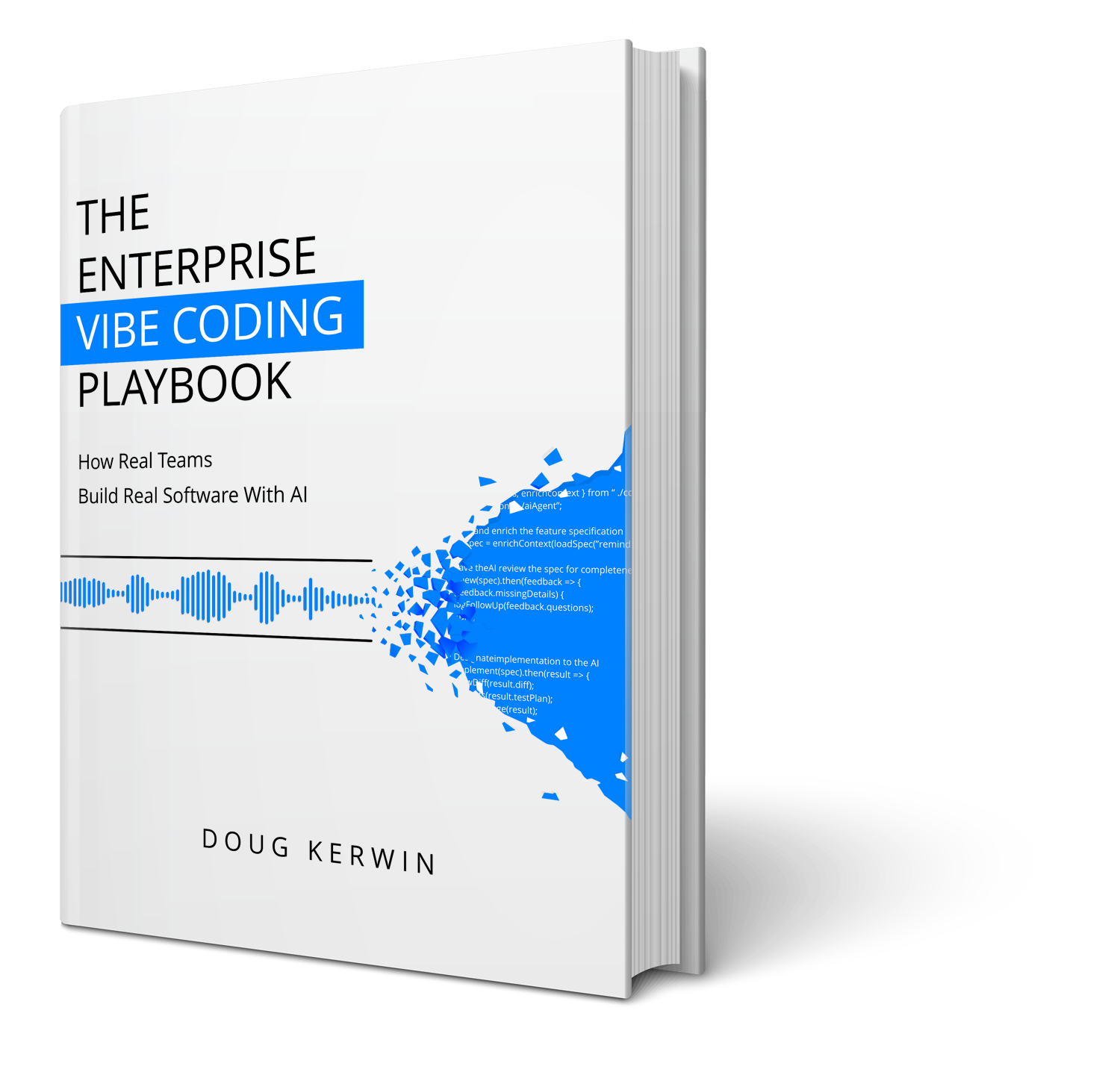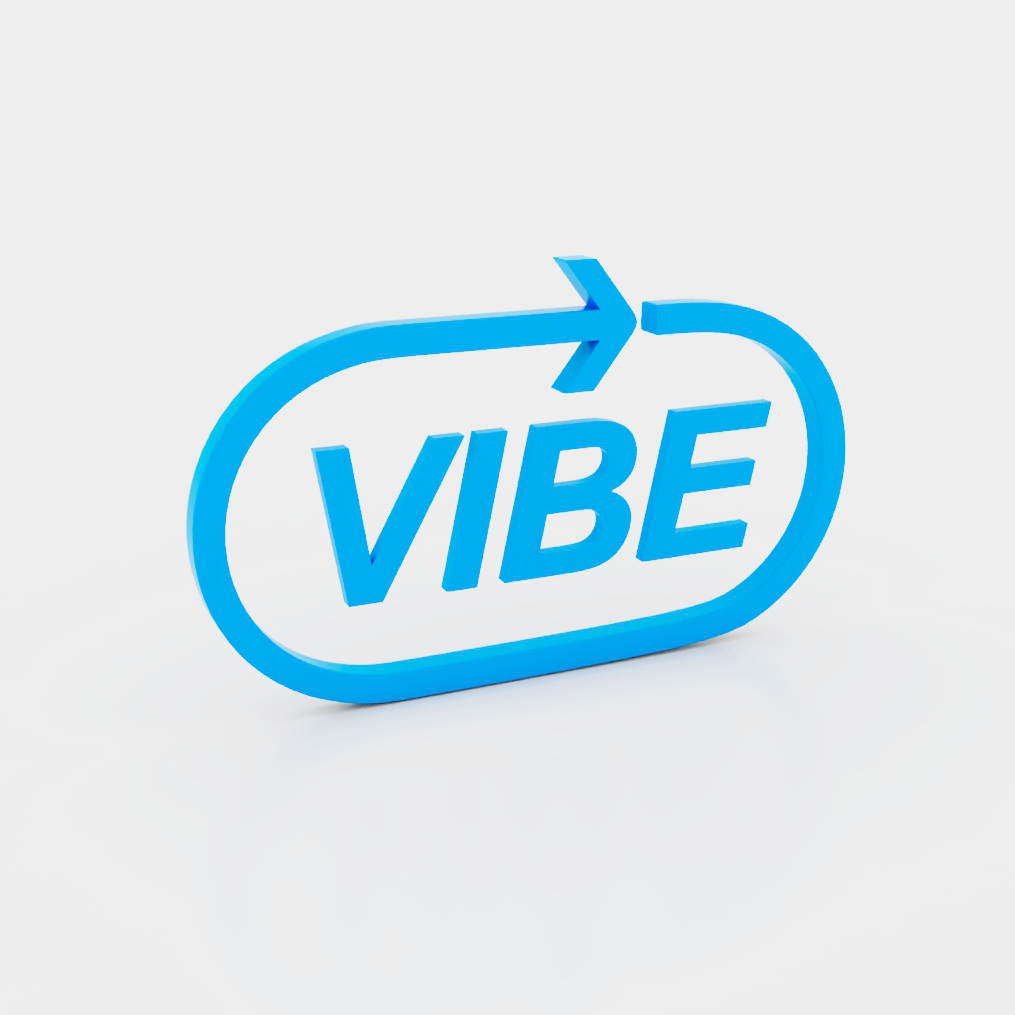
Build Real Software with AI - Not Just Demos
A practical, team-ready approach to modern development using tools like Cursor, Claude Code, and more.
Get the Book
Small teams are punching way above their weight by letting AI write the vast majority of their code, but this powerful new way of working is still flying under the radar for most companies. The conversation is stuck on weekend projects and demos, while the enterprise treats AI like a smarter autocomplete.
This book is for engineering leaders and experienced developers who want to build serious software with AI—and actually unlock the leverage it offers. It introduces a clear, step by step workflow that makes this approach reliable, repeatable, and scalable.
You’ll learn a practical, disciplined approach to building applications—not with AI as a co-pilot, but as the primary developer.
My Beef With “Vibe Coding”
I’m all-in on using AI to write nearly all of your code — in fact, I believe it can (and should) write almost all of it. I do it every day — in production apps that handle serious, real-world use cases.
But I’ve got a problem with the way “vibe coding” is usually portrayed.
Too often, it’s framed like magic: toss a prompt at the AI, and voilà — a game, a UI, a whole app. No planning, no review, no iteration. Just vibes.
The problem isn’t using AI to write all the code.
It’s pretending you don’t need to review, guide, or course correct.
That’s fine if you’re just trying to build something cool for fun — a weekend experiment, a flashy demo, something to show off.
But if you’re working on a real product — something your team will build on, something your business depends on — that approach falls apart fast.
Yes, AI will grind away at your request until it produces something that seems to work. But under the hood, it’s often a mess: shortcuts, fallbacks, fragile glue code, and tech debt baked in from the first commit. Good luck building on top of that later.
The problem isn’t using AI to write the code.
It’s expecting it to get everything right with a one-shot prompt and no plan.
It’s skipping the hard thinking — the real design — and expecting magic.
AI is powerful — but it still needs structure, clarity, and ongoing direction.
Just like a good mid-level developer, it can do great work if it knows exactly what’s expected — and if someone’s reviewing the output.
Vibe coding can work — but not the way it’s usually portrayed online.
It needs a methodology. It needs product thinking. And a repeatable process.
Let’s redefine vibe coding - for real work.
I’m not throwing out the idea of vibe coding. I’m evolving it. Real professional vibe coding means:
• Treating AI like a team member, not a magic wand
• Giving it context, structure, and oversight
• Building apps that actually ship - not just demos
• Staying in the loop and managing quality every step of the way
This isn’t “prompt once and hope.” It’s an iterative, intentional process - and it works.
About Me
I’m a VP of Engineering who’s been building real production software using AI since GitHub Copilot first launched — and I’ve taken it much further. Today, I use AI to build serious systems, including HIPAA-compliant apps like VillageMetrics, where essentially 100% of the code is AI-generated.
I’ve been an early adopter and daily user of tools like Cursor, Claude Code, Amazon Q Developer, ChatGPT, and WisprFlow — applying them across both startup and enterprise environments.
I teach this method to my own engineering team, and now I’m offering the same approach to yours.
The Enterprise VibeCoding Method
My method has been battle-tested on real apps — from a HIPAA-compliant health platform built entirely with this approach, to modern microservices and feature expansions integrated into existing production systems. It’s structured, teachable, and transformative — even when applied to complex, evolving codebases. Here’s a quick preview.
• Use tools like Cursor and WisprFlow to do the heavy lifting
• Talk to AI like a collaborator, not a genie
• Think epics, specs, and data models — not functions and syntax
• Multiply your impact with seed projects, effective prompting, and strong testing workflows
• Commit often, spec harder, and always review like a boss
Key Principles of the Enterprise Vibe Coding Method
• Think epics, specs, and data models — not functions and syntax
The heavy lifting isn’t in the code anymore — it’s in the clarity of what you’re building. Everything starts with well-structured, detailed requirements.
• Talk to AI like a collaborator, not a genie
This isn’t about one-shot prompts. It’s a real-time feedback loop: explain, review, correct, re-draft. You’re not “using” AI — you’re working with it.
• Use voice to accelerate and preserve depth
Whether you’re reviewing code, giving context, or drafting specs — voice lets you express more detail, faster. And when you’re in meetings, AI becomes a participant: listening to discussion, drafting stories, and iterating with the team.
• Effective use of Git — commit often, reset fast
AI can make sweeping changes quickly. Frequent commits give you the ability to backtrack cleanly when things go sideways.
• Strong test coverage is non-negotiable
When AI writes the code, your tests are your safety net. The speed of generation demands equal rigor in verification.
• You’re the spec writer and reviewer now
Writing code is no longer your primary task. Your job is to guide what gets built and ensure it’s built right. Even senior devs need to retrain for this.
The New Mantra
Your role has changed:
You’re no longer the hands-on coder.
You’re the manager of an AI developer.
Your job is now to guide, spec, and review — not touch the keyboard.
That’s not just true for junior devs — even senior engineers need to retrain for this shift.
And here’s where many teams get it wrong:
This doesn’t work if you treat it like a grassroots experiment. You can’t just tell your current devs to “start using AI more” and expect transformation. The workflow changes. The expectations change. The entire rhythm of building changes.
You need buy-in at the engineering leadership level — managers, directors, tech leads.
Because the real work has shifted from writing code to writing real, detailed specifications — the kind of specs that product managers and designers often only half-write, and developers used to fill in on the fly.
In traditional workflows:
• Devs figure out the fuzzy parts of a story during implementation
• They make assumptions, build based on them, and hope they’re right
• Sprint demo hits, and half the time, it’s not what the team wanted
• Then the back-and-forth cycle begins…
That’s the inefficiency this method fixes. The shift is from writing code to designing clarity.
If the AI doesn’t have a crystal clear picture of what it’s building, it will guess. And just like a junior dev, those guesses can derail the whole sprint. With the right mindset, structure, and collaboration, the AI can ship production-grade code. But only if you treat specification as the new development.
This is the work.
This is the method.
And once you see it, you won’t want to build any other way.
Work with Me…
I offer professional training for engineering teams ready to level up how they use AI in real world software development.
Whether you’re working with greenfield projects or modernizing existing systems, I’ll show your team how to:
• Structure specs so AI delivers clean, scalable code
• Integrate tools like Cursor and WisprFlow into your real workflow
• Multiply developer productivity with a repeatable, high-impact methodology
Tier 1: Team Introduction Session
A personalized walkthrough of the Enterprise VibeCoding method, tailored to your team’s questions and context
What’s included:
• 90-minute live session for up to 20 people
• Overview of the method: workflows, tools, common pitfalls, and mindset shift
• Live Q&A based on your team’s roles, goals, and current AI usage
• Great for teams just getting started or exploring next steps
This is ideal if:
You’re considering rolling out AI in your dev org and want a focused, contextual overview — with room for discussion.
Tier 2: Team Training
Structured training sessions to bring your team up to speed on real AI-powered development — not just prompting tips
What’s included:
• 3–4 live sessions delivered over 2–3 weeks
• Covers specs, prompt design, code review workflows, voice tools, and testing
• Tailored examples using your actual tech stack
• Optional: follow-up coaching or async support window
• Can be paired with a specific internal project
Most popular for teams actively working on delivery
Tier 3: Embedded Coaching Engagement
I integrate with your team for a limited period to coach them through real delivery using this methodology
What’s included:
• Short-term collaboration (2–4 weeks depending on need)
• Weekly sessions with developers, leads, and product stakeholders
• Live spec reviews, AI-driven architecture walkthroughs, and coding collaboration
• Slack/email/async feedback between sessions
• Tailored guidance on internal workflows and team alignment
• Limited to 2 teams/month
Best for orgs who want high-touch implementation on a real project








